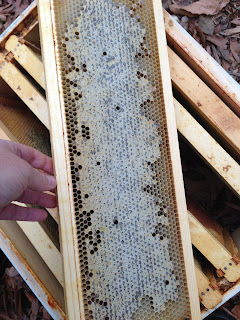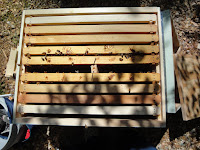 |
| Feeding Back Honey Using Entrance Feeders |
It's too cold for bees to be moving when I leave for work in the mornings and it's dark by the time I return home but I did observe activity at all the hives this weekend. All appeared well...
Until this morning when I pounded on the side of the Sasha hive. All was too quiet.... I lifted the outer cover to peek in the hole of the inner cover and there was not a bee in sight! Removing the inner cover, I could peer between the frames all the way through the three medium boxes down to the screened bottom board. Not a bee to be seen! By this I mean a live bee.
 |
| Frame of Capped Honey in the Sasha Hive |
There were two frames full of honey and another five frames partially full. The bottom box had five frames containing lots of pollen so if the bees had starved to death I would have found frames containing dead bees head-first in the cells, but the hive was completely void of any bees, dead or alive. There were perhaps a dozen dead bees on the bottom screen, certainly not enough to give an indication of a major die-off.
Did they swarm one unseasonably warm day? Highly unlikely as there really wasn't a reason to move on and they'd not have the ability to find food this time of year. I'm sad for the loss of the hive but everything is a learning experience and I'll do some research to see if I can determine what happened.
2012 has been a tough year for me as a beekeeper. It was my third season. I'm no longer a newbie with just enough experience to be comfortably dangerous. I mysteriously killed the Sasha queen early spring, killed my best queen in the OV hive when harvesting honey, experienced a major die off from the Dmitry hive, probably due to pesticides and now lost the Sasha hive. In 2013 I'm going back to thinking like a newbie!



















































